30 Hour Sous Vide Eye of Round Roast
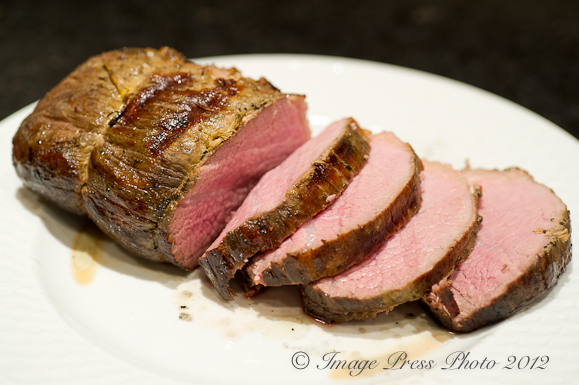
This post may contain affiliate links to products we use and love.
My husband Roger has written this post about our experiences cooking with the PolyScience Sous Vide Professional Chef Series. He has been the scientist behind all the madness in preparing and cooking foods by this method in our kitchen and he’s the analytic and mathematician in our family, so he’s here to explain the scientific aspects of cooking sous-vide.
Sous-vide (cooking foods in a vacuum sealed bag at low temperatures in water) has become all the rage. Most restaurant chefs and now many home cooks are discovering the benefits of this slow cook method. Chef Anthony Lamas a of Seviche, A Latin Restaurant, located in Louisville, Kentucky, recently said many people are using sous-vide just because it is the cool new kitchen tool. He said that sous-vide has its place and it should be selectively used in situations where it will improve the food.
With that in mind, I decided to experiment with sous-vide. I am a bit of an analytic so I knew I would come up with something that would appeal to engineers our readers and provide some very useful guidance.
One of the biggest benefits of sous-vide is that it allows you to slowly cook food to a precise temperature. Its not over-cooked or under-cooked. Cooking times are less precise as the food is brought to the exact temperature using the water circulator and then held at that temperature for as long as you leave it in the water bath.
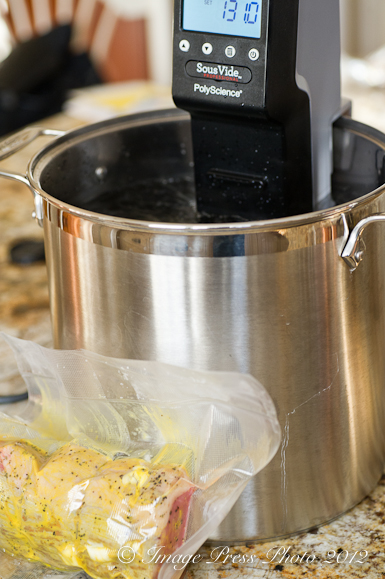
Beef Eye of Round Roast ready to go in the sous-vide water bath
All foods have different cooking temperatures in sous-vide. Here are the cooking temperatures for the water bath, which is also the final core temperature of the meat:
Short ribs medium 140° F
Roast beef medium 131° F
Tenderloin medium 142° F
Pork Tenderloin medium-rare 140° F
Salmon partially cooked 115° F
Flounder medium 117° F
Chicken 165° F
Sous-vide allows you to precisely achieve and hold the specified temperature. It is also easier to obtain very specific temperatures even up to 1/10 of one degree. Can you imagine trying to check the core temperature of a piece of flounder?
The other advantage is the longer you slow cook certain meats, the more tender they will become as the cooking time breaks down the collagens (also known as the connective tissue) in the meat. After all, if 24 hour short ribs are good, 72 hour short ribs must be better, right? Well, that is what I wanted to find out.
I decided to test various cooking times to determine if there is a point where additional cooking no longer provides a more tender meat and if so, what is that cooking time.
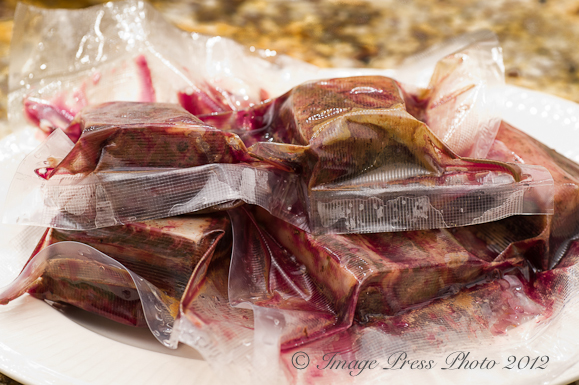
Three packages of short ribs that will be cooked for three different times
The verdict: Despite cooking the ribs 24, 48 or even 72 hours, the inside of the meat had a beautiful red center because of the sous-vide method. However, there were some differences. There is no question that cooking short ribs 24 hours in sous-vide provided a tender and perfectly cooked meat. At 48 hours the ribs continued to become more tender, however, we noticed that they seemed a little drier. At 72 hours the short ribs were definitely on the dry side. Yes, they were very tender, but we found that they required a sauce to supplement what we perceived to be a loss of moisture. This seemed odd since the meat is cooked in a sealed bag. Why would the meat become drier if the moisture could not escape the bag?
Okay, this really had me intrigued. A mystery to be solved. So, with pencil and graph paper in hand, I headed to the internet to find the clues.
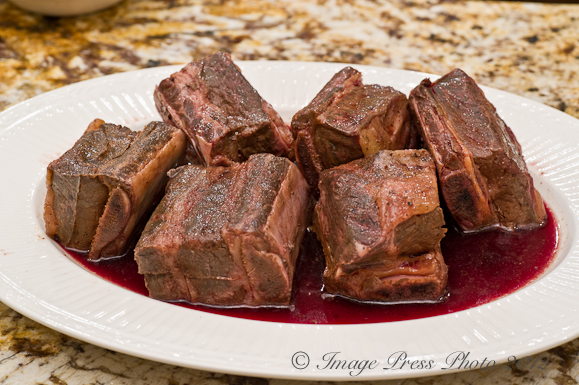
Short ribs that were cooked for 48 hours were more tender but seemed less moist
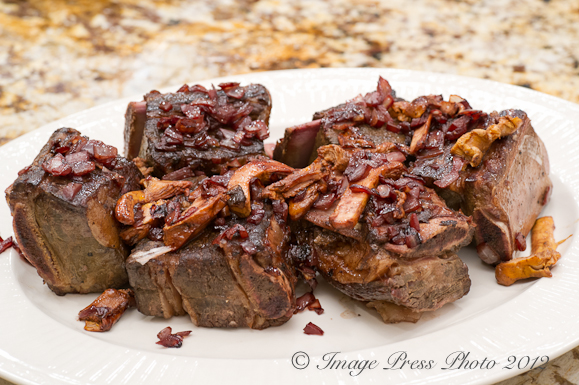
Short ribs cooked for 72 hours were very tender but were on the dry side
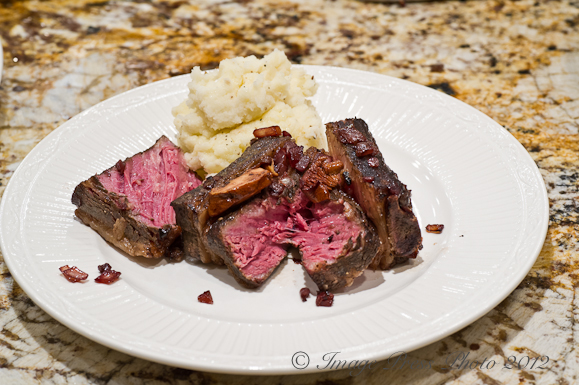
All of the short ribs were cooked to this temperature but the longer they cooked, the drier the meat became. Shown above, 24 hour sous-vide short ribs.
Very little has been written about this observation until I came across a scientific site called SciVerse. There is an article entitled “Physico-chemical, textural and structural characteristics of sous-vide cooked pork cheeks as affected by vacuum, cooking temperature, and cooking time.” I just knew it was going to be filled with charts, graphs, facts and scientific references that most of us won’t understand I find fascinating. Here is a link to the article if you want to numb your mind as well.
What I did learn from this article was that weight loss is lower and moisture content is higher the less the protein is cooked in the water bath. Also, meat cooked above 70-80 degrees centigrade increases the toughness of the meat as the proteins change. (scientifically it is called miofibrilar coagulation). Cooking longer periods of time, even at lower temperatures, resulted in more moisture loss.
I put this new found knowledge to the test on a beef eye of round roast. I knew that cooking this roast in the oven produced a somewhat dry and tough piece of meat. This cut of beef contains little fat and a lot of connective tissue; a perfect test for sous-vide (low fat, high connective tissue). The meat was seasoned with salt and pepper and I added a mustard and garlic rub.
I quickly seared the meat (this is an important step to kill any potential bacteria on the outside of the meat prior to cryovacing), placed it in a vacuum bag for sealing (but did not seal the bag yet) and cooled it in a ice bath (and important step after searing to bring the temperature down prior to sealing the bag and cooking as the meat will steam at low temperatures if it starts out warm when cooked under pressure). The searing prior to sous-vide is meant to drive flavors deep into the meat and produce a more flavorful roast than meerly seasoning the meat and cooking sous-vide. It was vacuum sealed by a FoodSaver and then cooked by sous-vide method at 131 degrees Fahrenheit for 30 hours. I believed this would provide sufficient time to break down the connective tissue and not dry out the protein. After removing the meat from the vacuum sealed bag I seared it off in a skillet to provide color and texture.

Quickly sear the eye of round rubbed in mustard and seasoned with salt and pepper
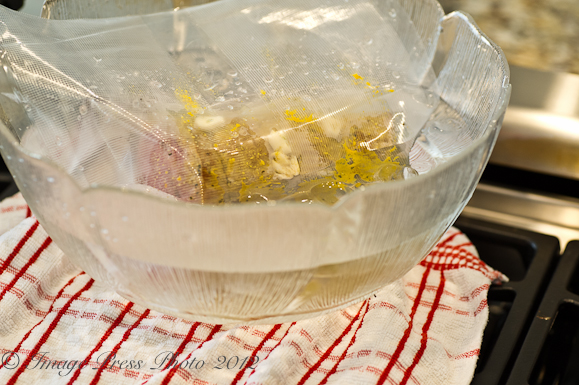
Cool the temperature down in an ice bath before putting it in the sous-vide bath
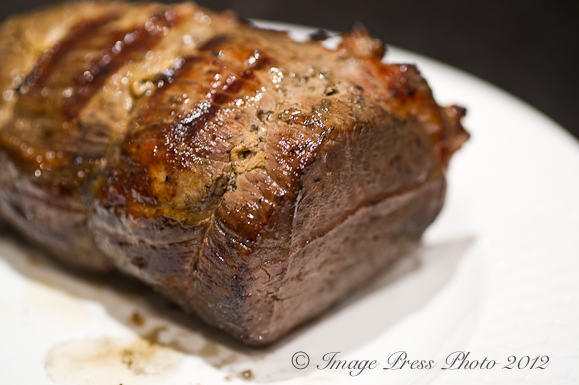
One final quick sear gives it a nice brown exterior
The Results: The beef eye of round was full of flavor and as tender as a tenderloin steak. Clearly, the long and slow, low temperature sous-vide cooking method produced a very high quality result. If I had continued to allow the eye of round to cook in the sous-vide water bath for another 24 to 48 hours it would result in loss of weight and a drier final product.
What you can learn from our experiments and research:
- Cooking sous-vide can make a dramatic difference in the quality of the final protein but choose wisely. The biggest difference is in cuts of red meat that are typically low in fat and high in connective tissue. We have also cooked fish with outstanding results which you can read about here.
- While you don’t have to be precise in the cooking time, you should be very precise in the cooking temperature.
- More is not always better. If 24 hours is good, 72 hours is not necessarily better. The longer you cook the protein the more it will dry out the meat, despite the juices being sealed in that vacuum bag.
* I undertook an additional experiment with lamb chops. The recommended cooking time for 1-inch lamb chops is 2 hours at 140 degrees Fahrenheit. Once again, 24 hours seemed to provide the best time to produce a more tender and moist chop.
Note: Please be advised that you should exercise caution when cooking sous-vide. Here are some food preparation tips.
Disclosure – PolyScience has provided us with the Sous Vide Professional Chef Series for our review. This is our preferred machine when preparing foods sous-vide, but the lower-priced PolyScience CREATIVE Series Sous Vide Circulator will also work well for a home cook. If you don’t want to invest quite that much in a circulator, we also own and use this version from Anova Culinary and can highly recommend it as well.
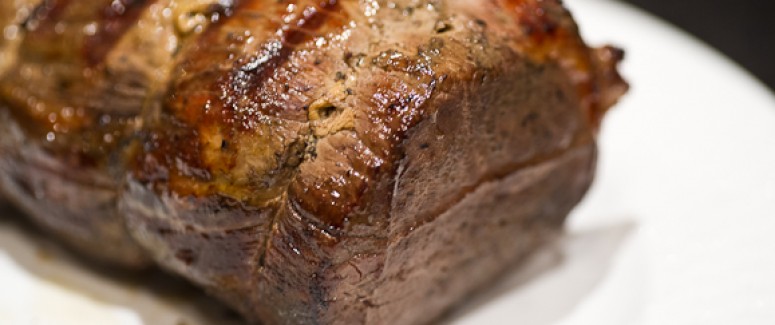
30 Hour Sous-Vide Eye of Round Roast
Ingredients:
3 lb. beef eye of round roast
yellow mustard
Extra-virgin olive oil
1 1/2 tablespoons black pepper
1 1/2 tablespoons sea salt
3 cloves garlic, chopped
Directions:
1. Liberally apply yellow mustard, half of the salt and half of the pepper to the eye of round. In a hot skillet, quickly sear the outside of the roast in a little olive oil. Do not try to cook the roast. A quick searing will kill any bacteria that is on the outside.
2. Reapply a generous coating of yellow mustard and the remaining salt and pepper. Add chopped garlic to the outside of the roast and place the roast in a bag that will be used for vacuum sealing.
3. Place the unsealed bag in ice water for about 10 minutes. This is a required step in sous-vide to bring the temperature of the meat back down.
4. Seal the bag using a vacuum seal system. If there are juices in the bag, you might want to freeze the bag for 5 minutes prior to sealing. This process will help prevent the juices from being sucked up and out of the bag which could prevent a good, tight seal. Place the bag in a circulating bath of 131 degrees (medium). Allow to process for 24-30 hours.
5. Remove the roast from the bag. Again, sear the roast in a hot skillet to provide a pleasing finish. Slice and serve.
* All content on this site is copyrighted and all rights are reserved by PratesiLiving.com. No content, written, photos or videos may be reproduced in whole or in part without express written permission. Use the Contact form on the top of the Home Page to address any questions or requests.